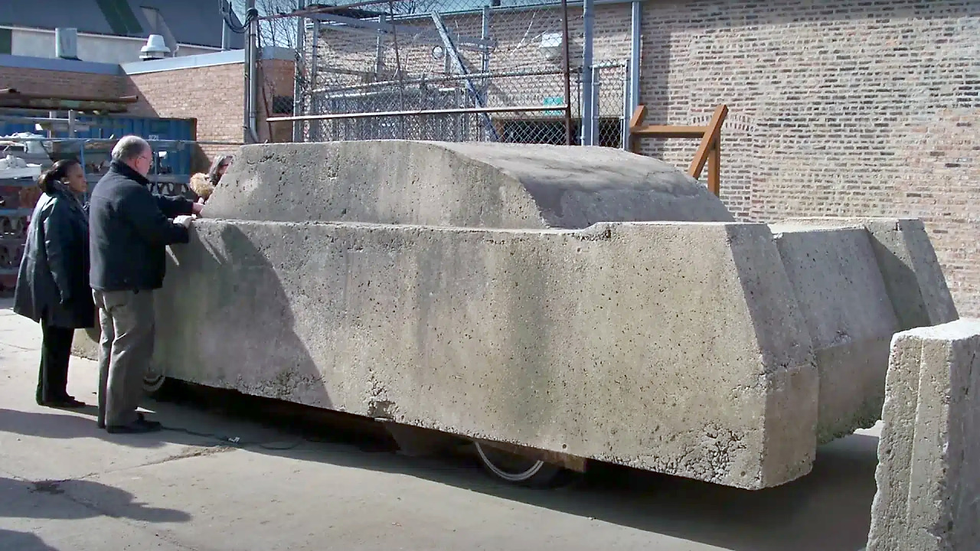1970 Lincoln Mark III Dual Cowl Phaeton Concept
- Story Cars

- Mar 17, 2022
- 4 min read
Lincoln came up with a racy show car for the 1970 auto shows based on the Continental Mark III. Based on a styling exercise done under the supervision of Ford styling chief Larry Shinoda, the Dual Cowl Phaeton made its initial appearance at the Detroit Auto Show in November 1969. It also appeared at the Chicago Automobile Show on February 21, 1970, and shows in New York and at the Texas State Fair. The car began life as a production Continental Mark III, which was modified by Kar Kraft and had the roof structure removed to make it into a faux convertible, as there was no provision made for a top of any kind. The windshield header was removed, and the A-pillars were cut down to facilitate a new custom windshield with a polished upper edge. The windshield glass dipped in the center along the top edge to form a cut-out section repeated on the rear windshield, which was two pieces mounted to the front seatbacks to fold forward with the seat for ease of entry and exit.
Most of the major body panels were modified. Only the hood, deck lid, and doors were stock Mark III parts. A sloping two-piece front header panel had angled upper and lower sections that created a vee horizontally where the two were joined together. This placed the concealed headlamp covers at an angle, and below them were rectangular parking and turn signal lights. The Mark III grille was customized and extended down beneath the car. It had a pronounced vertically-oriented vee shape, with the point of the vee jutting out even with the front fenders, which were rather pronounced compared to a production Mark III.
The taillights were removed from the edge of the rear fenders and placed in a custom rear bumper. The rectangular lights matched the shape and size of the front parking/signal lights. The front and rear fenders were blunt, with slightly rounded upper and lower corners. Front and rear side marker lights were slim vertical slits placed near the edges of the fenders. The door handles were removed, and electric door mechanisms were installed.
The Dual Cowl Phaeton was finished in a colorful Silver metal flake paint with a shadow paint treatment in charcoal gray metallic that ran along the lower edge of the body and followed the lower body line as it arced over the front and rear wheel opening flares. The two colors were carefully blended at the extreme front and rear of the car to avoid a line where the colors changed.
The car featured a dark red leather interior with corduroy inserts in the seats accented on the exterior by red band tires mounted on custom wheels that resembled the production turbine wheel covers, only they had a different offset. The center caps were stock Lincoln parts. The same wheel design was used on the 1969 Ford Thunderbird Saturn II Show Car, with different center caps, which was also a huge hit at the auto shows.
No performance modifications were made to the stock Lincoln drive train, although the car's appearance would certainly suggest otherwise. This concept car was designed and built to be displayed only, so it wouldn't make sense to do any mechanical upgrades. Unlike some Lincoln show cars of the past, this model was completely roadworthy and met all of the federal motor vehicle standards. It could be driven anywhere, as long as weather conditions didn't require a roof overhead for protection. The door and quarter windows were also missing, and the openings were covered with polished stainless trim.
Even though the car didn't have dual cowls, nor was it a true phaeton, the concept car was a big attraction at the auto shows. This styling exercise never seriously considered for production allowed Lincoln to test new styling ideas for public response and keep its new Continental Mark III personal luxury car in the news. This was a very sporty-looking car, and it reminded people of Lincoln's hot rod past. After meeting its auto show circuit obligations, the car was loaned to Marcelino Mercury in Puerto Rico to display in its showroom. This was the largest Lincoln-Mercury dealer outside of the United States, and the original agreement was that the dealer could display the car for one year, then it would be returned for destruction. At the end of that one-year period, Marcelino Rivera, the dealership owner, had grown very fond of the car and asked Ford to extend the display period for another year, which it did.
James Hodgins was the Sales and Marketing Manager of Overseas Operations for Ford and was in Puerto Rico in the fall of 1972 to launch the 1973 models. Knowing the time had come to return the show car, Rivera offered to buy it instead. He couldn't stand the thought of the car being destroyed. Ford initially rejected his offer but later changed its mind. Instead of selling it to Rivera, the car was awarded to Rivera's dealership to recognize its outstanding sales performance. The car remained on display at the dealership through 1973 and was beginning to suffer wear and tear due to exposure. The car was then moved to Rivera's house to be placed in covered storage for protection. Marcelino Rivera passed away in 1990, and Rivera's son, Rafael, restored the car in 1991. The car was offered at auction in February 2009. We hear it still survives today.
Source: automotivemileposts.com
Images: Lincoln-Mecury Division Ford Motor Company; www.chicagoautoshow.com




































Comments